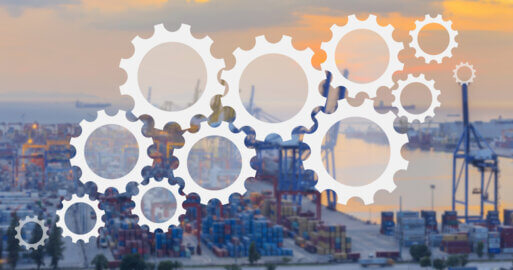Green Logistics: How Digitalization is Driving Sustainability in Logistics

Can digitalization help drive sustainability in the logistics sector? Oh yes! This is not merely possible, but in view of the climate targets that have been set, it is essential. This blog article takes a closer look at what exactly green logistics means and what measures logistics companies can take to increase sustainability.
Why make logistics more sustainable?
Sustainability and the environmentally-friendly stewardship of resources are very much on the political agenda at present, with pledges such as the German government’s commitment to becoming climate-neutral by 20451. Logistics will be playing an important role in achieving this goal, as the sector contributes to heavy traffic congestion, is responsible for high volumes of packaging material and waste and requires large storage areas to enable the way we live our lives. Road transport alone caused 19.4% of CO2 emissions in Germany in 20212, but is irreplaceable in a transnational supply chain. After all, goods need to get from A to B.
Digitalization and sustainability: a match made in heaven
On the one hand, digitalization is an operational necessity in order to maintain and increase competitiveness in highly competitive markets. However, digitalization also has the handy side-effect of improving sustainability as implementing digital solutions optimizes processes, increases efficiency and reduces a company’s carbon footprint. Digitalization is therefore a measure which serves both a company’s own interests and their corporate social responsibility (CSR). Two birds with one stone.
What is green logistics?
Everyone in logistics is talking about sustainability at the moment3. However, what do we actually mean by green logistics?
Green logistics refers to comprehensively redesigning strategies, structures, processes and systems in companies and corporate chains to create environmentally friendly and resource-efficient logistics processes. This transformation introduces crucial ecological aspects to the world of logistics by aiming to integrate sustainable practices into the entire logistics process.
The trend towards a greener logistics sector
The logistics industry is currently undergoing a major shift towards sustainability. In the corporate environment, you will find various stakeholder groups each with a different slant on green logistics:4
- Companies are grappling with this issue on their own initiative;
- Employees want to work for a socially responsible company;
- Customers and consumers want to use environmentally-friendly products and services;
- Non-Governmental Organizations (NGOs) are calling for greater, wide-ranging corporate social responsibility (CSR) measures;
- Politicians are developing national and international laws on sustainability;
- Investors are putting pressure on companies to become more sustainable.
Green logistics therefore needs to rebalance ecological and economic factors on a long-term basis.
What is the goal of sustainable logistics?
Green Logistics aims to minimize the environmentally harmful effects of logistics processes while also reducing the consumption of non-renewable and nearly non-renewable resources. Green logistics therefore addresses every internal and external logistics area and process. The aim is that every process in the supply chain, from warehousing, packaging, transportation and disposal management, be designed in such a way that they are not only economical, but also more ecologically sound.
What are the advantages of sustainable logistics?
It’s not just the environment that benefits from green logistics – companies also gain from conserving resources and more deliberate stewardship. They benefit from lower energy, material and personnel costs, while employees have a lower workload once processes have been digitalized. Simple warehouse activities, for example, are carried out by robots. Digital processes in particular ensure that everything runs smoothly, making production downtime rare. If machine data is also captured and analyzed, a company can use predictive maintenance to calculate when a machine needs to be serviced. Compared to companies who only focus on profit, companies seen to be working to protect our future have a competitive advantage for attracting new customers and retaining existing ones.5
How can you implement green logistics in different business areas?
Nearly every area of logistics could benefit from a green logistics approach.
Green logistics in transportation management
In green transportation management, the focus is on optimizing route planning and improving the fleet.
- Reducing fuel consumption, whether that’s switching to greener vehicles or other drive technologies, reduce a logistics company’s carbon footprint.
- Digital planning and fleet management systems help you optimize routes and journeys and prevent empty runs.
- Location simulation software helps you determine the ideal location for your warehouse or production facility to cut down on mileage.
Integrating digital planning and information systems helps you implement all these measures, leading to more sustainable transport management in your logistics operations.
Green logistics in warehouse management
There are many ways you can improve sustainability in warehouse and inventory management:
- Large warehouse roofs are ideal for solar panels.
- A well-insulated building reduces energy consumption.
- Strategically planned and positioned warm and cool storage facilities help prevent products that need cooling being placed near products which need warm storage.
- You can digitalize and streamline your facilities through modern storage systems and administrative software.6
Green Logistics in packaging logistics
Sustainable packaging logistics involves avoiding unnecessary packaging and recycling and reusing what is used.7 This green outlook starts before the packaging has been produced, with attention paid to sourcing raw materials with as little impact on the environment as possible, and using climate-neutral energy during actual production. The packaging produced is then reused several times, recycled after use or repaired if damaged. Companies can use data analytics to determine when they need new packaging and to what extent, as well as how much recyclable or reusable material they have in stock.
Green logistics in waste management
Green logistics measures for waste disposal include reducing waste volume and resource usage, such as water and energy. Introducing a strict recycling system also makes waste management far more environmentally friendly. As well as reducing waste, planning how you dispose of your waste also conserves resources. Instead of sending off recycling loads as and when, employing data analytics can help you ensure that the vehicles are travelling at capacity, reducing the number of trips they need to take. Equally, reducing the volume of waste also reduces the amount of waste disposal trips.
Sustainable logistics through digital transformation and data integration
The key to sustainable logistics through digitalization and data integration is the availability of data in each of the areas listed above. Sustainable and green logistics only works with data integration. This is why digitalization and automation play a crucial role in a large number of areas for green logistics.
In transportation, for example, digital transformation helps you improve capacity planning. If you have data on the type of journeys you need to make, as well as the destinations and times, you can load your vehicles more effectively and avoid expensive empty runs harming the environment.
Digitalization is also helpful for increasing the sustainability credentials of your packaging logistics. If a key account always orders a large amount of goods and logistics companies consolidate these into one vehicle, companies not only save on transportation, but also on packaging.
Efficient warehouse management software really raises the game when it comes to optimizing your processes and making them sustainable. You can further employ software and other technologies in innovative order picking techniques such as Pick by Light, Pick by Vision and Pick by Voice.
- The Pick by Light picking technique is completely paperless. The order picker is led by lights to where he needs to fetch something in the warehouse.
- Another paperless picking method is Pick by Vision. Here, augmented reality and wearables give the order picker the information he needs to find the product. He just needs a pair of smart glasses.
- In Pick by Voice, the order picker wears a headset and is told by the system where to go and what to pick.
Optimizing the supply chain to drive green logistics
Modern supply chains are global, complex and involve numerous parties. However, if we are aiming for sustainable logistics, we should not forget the greenhouse gas emissions created by the global supply chain and should streamline the chain. This involves topics such as nearshoring, optimized sourcing, urban logistics and the issue of the last mile. A logistics company can also be made more sustainable by introducing a new service model or engaging in collaborative logistics such as sharing vehicles and infrastructure with other companies. Finally, there are several innovative start-ups, universities and other research institutions who are helping to implement sustainable measures in a meaningful way.
How can you get started in sustainable logistics?
Green logistics starts with the provision and use of data. Every company already has this data. However, it is often stored in different places in different systems and in most cases is not being properly exploited. In order to use your data to its full scope, you need to start with professional data integration. And the best thing is: any company can start right away.
Green Logistics is closely tied to digitalization and data. It can be applied in all areas within logistics to make logistics companies digital and sustainable.
How can SEEBURGER help you implement green logistics?
Without meaningfully integrating substantial data into your processes, it is difficult to implement green logistics. We support you in your goal of making your company more sustainable by integrating the data streams that control physical logistics processes with the IT systems of each player along the supply chain. This creates a digital logistics ecosystem. Internal processes are easily connected with our EAI and API capabilities, external suppliers with B2B/EDI and MFT or through SEEBURGER connectors.
Essentially, the more data you have available, the faster you can provision it and the larger the circle that benefits from the data, the more a company and its partners can streamline processes. And that saves energy and resources.
1 cf. German Federal Government: Mehr Klimaschutz: EU soll bis 2050 klimaneutral sein (accessed on 02.02.2024).
2 cf. Emissionen des Verkehrs | Umweltbundesamt (accessed on 09.02.2024).
3 cf. Nachhaltigkeit in der Logistik – Fraunhofer IML (accessed on 13.02.2024).
4 cf. Nachhaltigkeit in Transport und Logistik – PwC (accessed on 21.02.2024).
5 cf. Green Logistics: Wie wird das Transportwesen nachhaltiger? (accessed on 22.02.2024).
6 cf. Green Logistics: Wie wird das Transportwesen nachhaltiger? (accessed on 22.02.2024).
7 cf. TUP Green Logistics (abgerufen am 03.06.2022).
Thank you for your message
We appreciate your interest in SEEBURGER
Get in contact with us:
Please enter details about your project in the message section so we can direct your inquiry to the right consultant.
Written by: Dirk Gawlick
After studying logistics, Dirk Gawlick was able to demonstrate his expertise in process optimisation for supply chains at several well-known logistics companies. Dirk has been an account manager in the logistics division at SEEBURGER since 2017.





